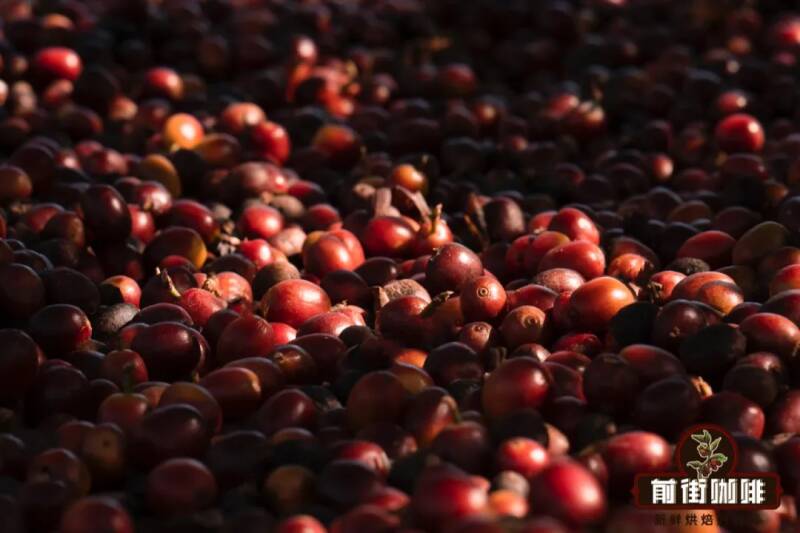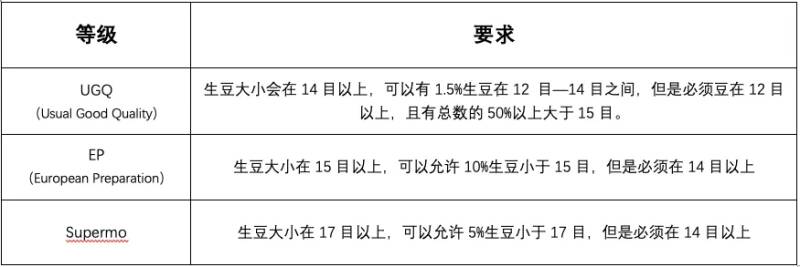Three major grading standards for raw coffee beans! Detailed explanation of the classification of raw coffee beans in different countries! What do AA and G1 in coffee beans mean?
As we all know, coffee beans belong to agricultural products. Agricultural products can not be almost perfectly reproduced like industrial products, so this leads to mixed quality of agricultural products. Therefore, in order to unify the quality, we need a corresponding system to standardize the quality of coffee beans, on the one hand, to ensure the quality, and on the other hand, to provide reference value for buyers who purchase raw beans. Therefore, the "grade" was born. But! As coffee beans are planted all over the world, the span is very large, and the geographical environment and planting patterns of each producing area are different, so there is no way to use a unified standard to classify coffee beans. In the end, the grading standards of coffee beans in each producing area will proceed according to the national conditions and adjust measures to local conditions.

At present, the classification standards of coffee beans are mainly divided into three categories: size, altitude (hardness), defect rate. Although they are mainly divided into three categories, they are not the only criteria for setting grades. Many countries use a variety of ways to grade coffee beans, such as altitude and size. Even, some countries will fill the shortcomings of the original grading system by cup test after determining the grade. All in all, although these three are the most commonly used grading methods, they are not the only indicators.
First, sieve grading (bean size) sieve grading is easy to understand, that is, coffee beans are directly measured by a specific type of sieve, and then graded according to the size of the beans. The bigger the beans, the higher the grade (except for beans). In the article "Kenya grading", Qianjie mentioned that this grading method is the earliest coffee bean grading system, so some countries that have been growing coffee since early days use this method to grade coffee beans.
As we all know, bean size cannot be used as a criterion for the taste of coffee beans. The reason for this classification is that many producing areas think that coffee beans are full, neat and large, indicating that they have completely reached a mature state. This kind of beans not only achieve a more comprehensive flavor transformation during growth, but also beans of the same size will be more conducive to uniform roasting, making the flavor of the roasted coffee more consistent. Kenya, on the other hand, is a coffee-producing country based solely on particle size, which is graded as follows:
In addition to the above grades, Kenyan coffee also has secondary grading marks such as Top/Plus (+) / FAQ. But these are the grading methods of local coffee research institutions and raw coffee bean traders (rated by cup taste test). So Qianjie does not repeat too much here, interested friends can click on the above Kenyan article to jump to understand. Colombia's coffee beans for export are also graded in size, but if coffee beans want to be qualified for export, they must first pass the assessment criteria, which are as follows: the size needs to be more than 14 mesh. In general, 50% of raw coffee beans must be larger than 15 mesh, and no more than 5% of raw coffee beans must be between 12 and 14 mesh, and they need to be pest-free, uniform color, no smell and clean flavor. The moisture content shall not exceed 12.5%, and the accumulated defects shall not exceed the stipulation of 24 points.
When the conditions are met, the coffee beans can be qualified for export and receive the grade mark of "Excelso". Then carry on another round of size classification, you can carry on the export. And their sizes are classified as follows:

Second, altitude / hardness grading, as Qianjie often says, the size of coffee beans does not directly determine the formation of coffee flavor. So some Central and South American countries use the altitude at which coffee is grown to determine the grade of beans. Because the higher the altitude, the more substances the beans can absorb, the higher the density, and the better the flavor. Panama, Costa Rica, Guatemala, Honduras and other coffee-producing countries have adopted this model. However, because the elevations of each country are different, their grading system will also be adapted to local conditions. The following is an overview of the elevation classification.
Third, the defect classification method is precisely because coffee beans belong to agricultural products, so coffee fruits are easily affected by negative factors (dysplasia, insect pests, pathological changes, mildew, etc.) in the process of growth, and then turn into defective beans. The existence of defective beans will have a great negative impact on the flavor of coffee, so there is a classification standard based on the proportion of defective beans in raw coffee beans.
In the early days, Ethiopia was a coffee producer using a defect rate classification system, and it was the most typical example of adapting measures to local conditions. The reason for adopting defect classification is that Ethiopia has a high average altitude and does not need to use altitude as the classification standard of coffee beans, and because most of the coffee cultivation and harvest in Ethiopia are mixed mode: mixed planting and mixed harvest. In the past, few people would deliberately make a distinction, which led to different varieties and sizes of coffee beans. Then it is impossible to use the size classification system to define the grade, only the defect rate can be used. The earliest classification system in Ethiopia is as follows:
Similarly, the defect rate classification is the same as the size classification, with defects. So in 2009, Ethiopia launched a new grading system: on the basis of the original defect rate classification, increase the cup test score to carry out a comprehensive rating.
With a combination of multiple ways of grading, then Qianjie will share a grading system that combines multiple ways, first of all, from Jamaica, which is home to the emperor of coffee! The Coffee Industry Council of Jamaica, CIB, graded coffee grown in the Blue Mountains according to altitude (cup performance), raw bean size, and defect rate (as well as moisture content, color, evenness).
Indonesia's coffee grading system combines defects and size, first according to the number of defects in 300g raw bean samples to remove this rating, and then sieve the size.
The G1 grade of Indonesian coffee is required to be 18 items, which is the highest national standard in Indonesia. And PWN's gold manning will have higher standards and better quality, but it belongs to PWN's own enterprise standard (for more information, you can learn about "golden manning"). And Brazil! Because the grading system adopted in Brazil comes from the New York Coffee and Raw Bean Association (Green Coffee Association of New York) in the United States, its rating logo begins with "NY" (New York). This system combines the defect rate and size, first identify the defect rate of coffee beans, and then screen the size.
It is worth mentioning that Brazil does not have a "NY1" level. Because the defect requirement for Brazilian coffee beans to reach the second grade (NY2) is no more than 6 per 300g, then the first grade should be a lower number. Brazil believes that coffee is an agricultural product, and the use of purely mechanized harvesting, it is impossible to achieve flawless. Therefore, the upper limit of Brazil's level is NY2. Finally, Qianjie still needs to mention that the grade of coffee beans is only related to raw beans, which is something that raw bean merchants and roasters need to pay attention to. As consumers of cooked beans, we do not need to pay too much attention to them. On the one hand, it is because the raw coffee beans that are too low are produced and sold by the country of production, and on the other hand, because the grade is not completely bundled with the quality. Take Ethiopia's G1 and G2, for example, which are only different from the number of defects. On the other hand, bakers will not tolerate flaws in their work and will be screened out before and after baking. Therefore, to feel the delicacy of coffee is what we ripe bean consumers should enjoy.
-END-
Important Notice :
前街咖啡 FrontStreet Coffee has moved to new addredd:
FrontStreet Coffee Address: 315,Donghua East Road,GuangZhou
Tel:020 38364473
- Prev

Why is milk foaming quickly? Why did the latte defrost just a few minutes after it was made? How to reduce the disintegration of milk coffee foam?
I don't know if you have noticed the changes in the layer of milk foam on the surface of the hot latte after being placed for a long time. Is it lasting and "eternal youth"? Or is it disintegrating and unsightly? In fact, both of these can occur, because the essence of milk bubbles is bubbles. The liquid film that surrounds the gas will be lost
- Next

What is the concept of 9bar for an espresso machine? How much pressure does it take to make espresso coffee?
Qian Jie shared in the article "The Importance of Cloth and Pressing Powder" that in the preparatory process before concentration and extraction, whether the coffee powder is evenly distributed in the powder bowl and whether the force is evenly applied during filling and pressing will all be left and right. Extraction affects the taste of espresso coffee. But because it does not mention the force to use to press the powder, there are many
Related
- Being chased out of the rain in front of Starbucks?! Store: Sheltering from rain under umbrellas poses a safety hazard
- The white moonlight has changed?! Lucky launches "Big Winter Pear American"
- Hand-brewed coffee three-stage method, high-sweet and universal brewing method to share! What does the high sweet water level of hand-brewed coffee mean?
- What is the difference between raw, refined and full espresso coffee? How to extract espresso and taste good?
- A complete list of coffee bean names and their meanings! What is Yejia Shefi coffee? Where is Mantelin coffee?
- What grade does Arida Manor Kaduai coffee beans belong to? What treatment is Arida ASD slow anaerobic sun exposure?
- The milk tea cup becomes smaller?! Overlord Tea Girl launches a new "Return to Yunnan" series
- Accused of selling counterfeit and high-priced coffee beans! Well-known boutique coffee brand "Oukelao" bowed and apologized!
- How to make espresso dumplings? Can I eat coffee and glutinous rice balls together?
- Save the unformed and stagnant powder cakes in one second! What is the problem with stagnant water in the powder bowl of the espresso machine?

